Huobi Ventures latest research report: Will the Web3 social track be the next bull market engine?
Author: Juliet Tang, Investment Analyst at Huobi Ventures
Every bull market has different engines of initiation, and behind each bull market engine lies a long and intricate bear market development history. Crazy MEMEs, the summer of DeFi… With the development of Web3 technology and infrastructure, the social track has also ushered in new development opportunities.
Will the Web3 Social Track Be the Next Bull Market Engine?
As a track that requires developers to fully unleash their imagination at the application layer, social, identity, NFT, DAO, fans, and more can all be classified under the Web3 social category. The social track is currently still in its very early stages. With the launch of the Cyber token, Twitter's rebranding, and creator incentive programs, the market heat for the social track is gradually rising.
The social application Friend.Tech on the L2 chain BASE has rapidly gained popularity since its launch on August 10. In less than 20 days since its launch, it has already registered over 120,000 addresses, with more than 20,000 active addresses.
Applications and tools like CyberConnect and Lens Protocol have also attracted a large number of users and market attention.
This article explores the current development status of Web3 social, the characteristics of track products, and analyzes several leading projects within the track. Additionally, it studies the risks and challenges faced by this track. Overall, we are optimistic about the future of the Web3 social track, as this sector has good investment potential and development prospects.
This research report is produced by Huobi Ventures, the global investment arm of Huobi, integrating investment, incubation, and research to identify the best and most promising projects worldwide.
Why Focus on Social?
The crypto track has always been seen as an interdisciplinary science that combines computer science, finance, cryptography, mathematics, and more. However, due to its relatively short emergence, incomplete infrastructure, inconsistent regulatory standards, and certain learning thresholds and costs, it has yet to achieve widespread global adoption and use. With the construction of smart contract public chains represented by Ethereum becoming increasingly mature, the development of on-chain DApps has also seen an explosion since 2020. As shown in the figure below, the cumulative number of DeFi user addresses has exceeded 40 million. DeFi was the first to bring users into on-chain interactions, and its real and convenient application scenarios have driven the construction and development of the on-chain economy, attracting and nurturing a group of on-chain Degens. Subsequently, in 2021, blockchain games and NFTs began to lead a new wave of user influx. New on-chain gameplay, the Ponzi-like token economic design, and diverse value systems have helped the Web3 field attract a large number of new users. Among them, blockchain games have attracted many Web2 gamers and low-income groups from the third world due to their money-making effects, while NFTs, with their identity, collectible, and brand value attributes, have attracted many collectors, art enthusiasts, and various traditional brands.
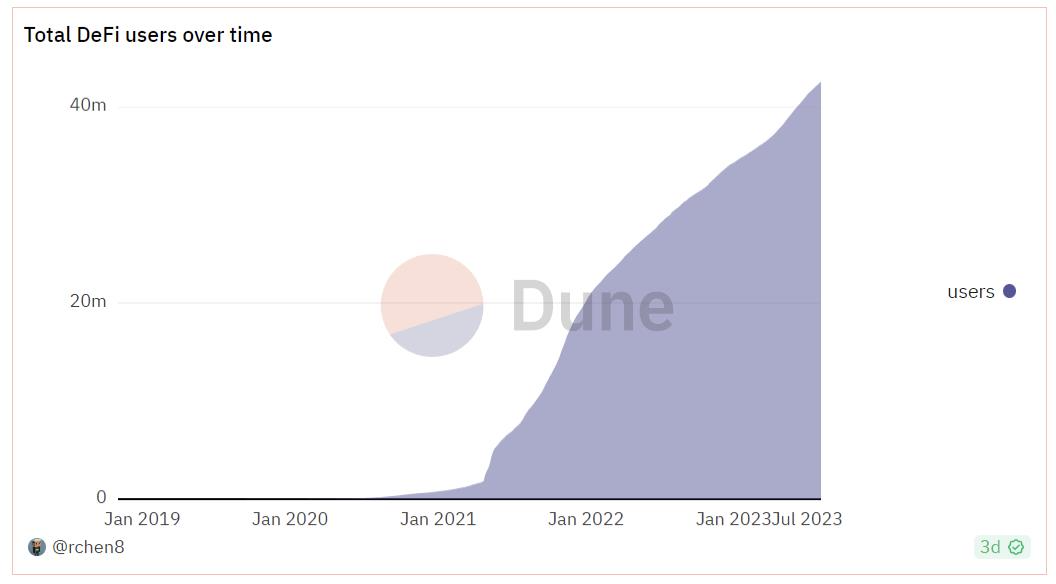
Cumulative DeFi User Address Count Across All Chains
Since 2022, the market has entered a prolonged bear market, with the previously booming gaming and NFT sectors losing heat, and Ponzi economic models collapsing rapidly due to insufficient incremental growth. The growth of Web3 users has hit a bottleneck. Currently, Web3 innovation continues, with developers exploring new possibilities in infrastructure, zero-knowledge proofs, payments, identity, DeFi 2.0, and other fields. However, the small number of users remains one of the core issues facing the development of the Web3 field. Today, in this bear market, many ecosystems and their projects face the dilemma of having completed construction but lacking real users. Excluding various airdrop studios and multi-wallet users, the number of real on-chain users may not be optimistic.
From the supply side, the current development of Web3 needs to expand more application scenarios and create more ways to attract new users. Currently, the social track is expected to become the next track to ignite Web3 users. From the demand side, the social track has been proven to have strong potential in the traditional internet field, with a huge user base and commercial value being fully realized. From the early MSN to the mid-stage Facebook, Instagram, and later TikTok, each technological iteration in the social track has been accompanied by the birth of internet giants, generating numerous job opportunities in the upstream and downstream of the industry. As people's awareness of the privacy and commercial value of data ownership increases, more voices are calling for users to control their social information and data through Web3, allowing them to enjoy the value of their identity and behavioral data. Therefore, exploring social projects within the Web3 field is one of the most promising and commercially valuable topics in the near future.
With the maturation of ecosystems like Cyber Connect and Lens Protocol, the entire social sector is becoming increasingly robust. Currently, the social sector is in the early stages of an explosion, with some social projects recently attracting market attention. For example, Elon Musk, the biggest KOL in the crypto circle, took over Twitter, and his repeated endorsements of Dogecoin and the inclusion of Bitcoin in Tesla's official documents have brought global traffic to the crypto field. Although he stated that Twitter will never issue tokens, speculations around Twitter's social identity, token reward payments, etc., have been discussed in the market for a long time. Additionally, Lens Protocol completed a $15 million financing round, internet social giants like Instagram are issuing NFTs, and Cyber tokens have simultaneously launched on multiple leading exchanges, indicating industry expansion and development.
Characteristics of the Social Track
Currently, there is no unified definition for Web3 social. We can categorize all products related to information publishing, exchange, and user characterization into the social domain. From the current development achievements, it mainly includes social public chains, social graphs, social identities, various types of social applications, and service tools.
In the Web2 field, traditional social platforms like Twitter, Instagram, and TikTok already have a large number of users and have developed mature and rich business models. When we mention Web3 social, we need to validate the necessity and feasibility of developing Web3 social. Compared to Web2, Web3 has a smaller user base for social development and is still in the exploratory stage of technology. Overall, this article believes that the key factors for the development of Web3 social include:
1. Anonymity and Anti-Censorship
One of the biggest advantages of Web3 social compared to Web2 social is its anonymity and anti-censorship. This characteristic has already been validated as one of the user demands today. In the Web2 field, data is controlled by centralized institutions, and users may be arbitrarily censored regarding their data, forced to delete or modify their social statements, etc. Essentially, Web2 social remains a regulated social model where users cannot protect their privacy. In contrast, decentralized Web3 inherently possesses the characteristics of protecting user privacy and resisting censorship from centralized institutions, which can meet users' demands for privacy protection and personal security.
2. Users Control Data Ownership
In the Web2 social model, users' data ownership belongs to centralized platform institutions. By controlling user data, platforms can create user profiles, analyze user behavior preferences, and then deliver corresponding advertisements and products to maximize monetization, while the data itself also has certain commercial analytical value. In the Web3 field, enabling users to control data ownership allows them to obtain the commercial value of data traffic. From the user's perspective, designing projects that enable users to conveniently realize data value monetization is attractive. In fact, this model has already been attempted in Web2 business models with some success. For example, Pinduoduo offers cash rewards for watching videos, and inviting friends to participate in "cutting a knife" (essentially a social network for user acquisition) also provides cash rewards for users to realize traffic monetization.
Currently, there have been many attempts in the Web3 field in this area, such as Nostra based on the Bitcoin Lightning Network, Lens based on Polygon, and the multi-chain protocol CyberConnect, all attempting to return data ownership to users. This article believes that in Web3, due to the diversity of tokens, the volatility of token values, and the richness of token economic design, the commercial value of data ownership can give rise to many interesting ways to attract users, potentially creating wealth effects and user acquisition effects that even exceed those generated during the last blockchain gaming bull market.
3. Simplicity and Ease of Use
One of the elements of social projects is to achieve abundant and free-flowing information within circles, and abundant information relies on a large number of users. How to attract a large number of users is the biggest challenge and opportunity faced by Web3 social projects. One of the important reasons limiting the development of the crypto field is the small user base. First, there is a certain learning threshold for users entering the crypto field; they need to master some computer and cryptographic knowledge to participate in on-chain interactions. Second, current crypto projects are relatively complex compared to Web2 user tools, lacking simplicity and convenience. For example, with EOA wallets, complex mnemonic phrases and storage methods, potential risks of phishing and private key theft, and issues with software updates and compatibility all affect user experience. This keeps a large number of Web2 users outside the crypto world. Relatively, this also means that once the issues of learning costs and entry barriers are resolved, and a social project that is easy to use and allows users to operate without feeling it is born, it will bring a huge influx of users.
4. Composability
In Web2 social, due to the existence of various centralized institutions, large data islands have formed. The internet giants formed by these massive data islands have data access permissions and pricing power. Other projects wanting to use this data or build applications on it need to obtain permission from all data ownership institutions. Additionally, there are compatibility issues and potential competitive relationships between these large data islands, resulting in many Web2 applications not being interoperable. Users often have to register new accounts and accumulate information and data anew when using a single platform. This article believes that ideal Web3 social products may have the opportunity to solve the data island problem. Projects like POAP and ENS that depict user profiles can be seen as attempts to address the data island issue. In the future, there may emerge simpler, barrier-free standard protocols that help users conveniently master data ownership while being compatible with most protocols, which is one of the key exploration directions of DID.
Overview of Leading Projects
According to different project types, social projects mainly include social graphs, social applications, and tool projects.
Social Graphs
Social graphs serve as infrastructure in Web3 social, providing common standards and data information sources for other application projects. Social graphs should have rich data sources, broad composability, and low usage thresholds. From this perspective, there is little necessity for newly constructed social projects on new public chains or native social projects on obscure public chains, as they increase isolation from other mature ecosystems. Currently, building social identity common standards on mature chains is the mainstream choice for the development of social graphs, including mainstream projects like Lens Protocol, CyberConnect, and RSS3.
CyberConnect
CyberConnect is a multi-chain social graph that can verify and consolidate user interaction data, providing users with personal cards, social graphs, and smart contract wallets, while offering standard API data interfaces for other DApp developers to facilitate user data migration across multiple DApps. Currently, CyberConnect has integrated with Polygon, Linea, and Optimism, and will further integrate with Arbitrum and other networks, with user numbers expected to grow further. As shown in the figure below, as of August 8, 2023, the cumulative number of accounts reached 368,000, with a total of 738,000 user operations, and the total user profiles have exceeded 1.25 million.

Despite the currently sluggish market conditions, CyberConnect's daily active users (DAU) still maintain above 10,000, indicating a large overall traffic volume.
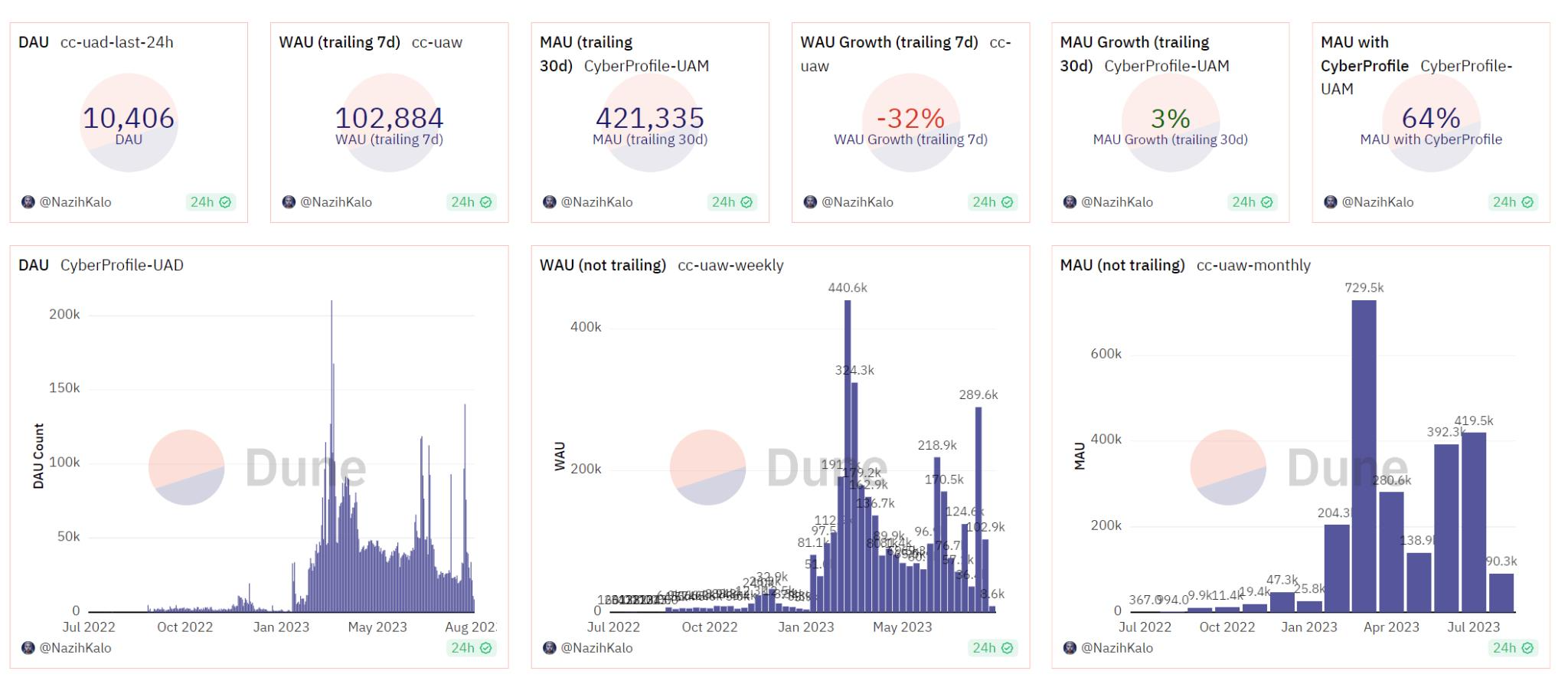
Lens Protocol
Lens Protocol is a social project developed by the well-known DeFi lending project AAVE team, built on Polygon as a social graph protocol. It allows anyone to create non-custodial social profiles and build new social DApps. Users can create their social profile NFTs by connecting wallets and interact with other users using these social profiles. Users can also build corresponding interactive DApps based on Lens (users can log in using Lens, interact within the Lens ecosystem, and interaction records will be stored in the Lens social profile).
The figure below shows some projects within the Lens ecosystem. Currently, over 100 projects have been built on the Lens ecosystem, including various social, play-to-earn, streaming sharing, DAO tools, advertising management, information dissemination, knowledge payment, lottery, and other DApps. Although most ecosystem projects are still in the early to mid-development stages, the overall quantity and variety are very rich, with the richness of its ecosystem even surpassing some public chains. Overall, the on-chain social ecosystem created by Lens is very friendly to the creator economy.
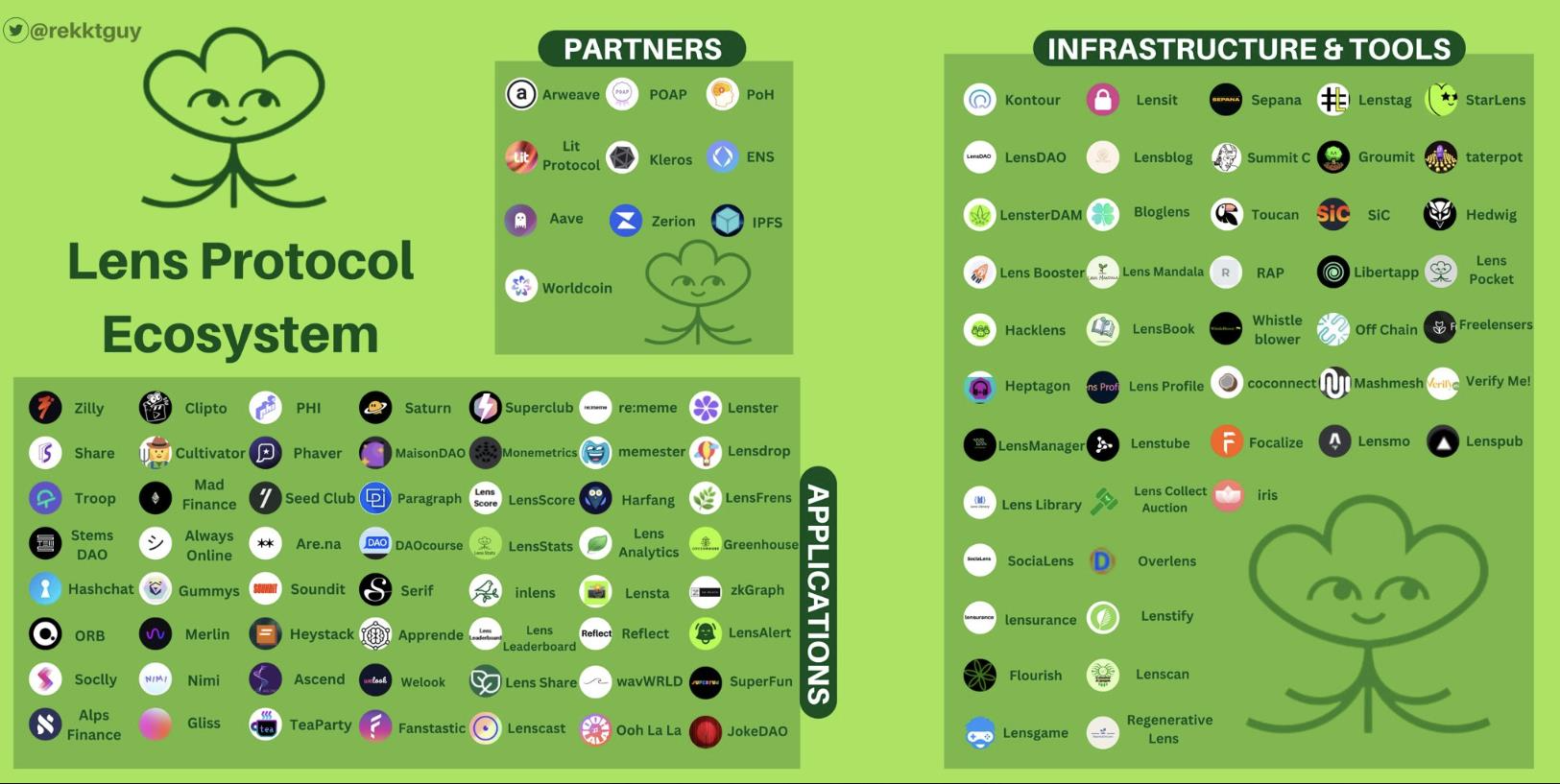
Lens Protocol Some Ecosystem Projects
As of July 2023, over 110,000 addresses have obtained Profile social cards. As shown in the figure below, Lens has accumulated over 360,000 users, with a total of 21.93 million transactions. The peak of transaction and user numbers occurred in February 2023, possibly due to a large number of retail investors or airdrop studios participating in the layout. Currently, the daily on-chain transaction count is between 15,000 and 20,000, with daily interactive users ranging from 3,000 to 5,000 wallet addresses. Even in the bear market, a considerable number of users are still participating in interactions within the social track, demonstrating good user data performance and growth potential for this track.
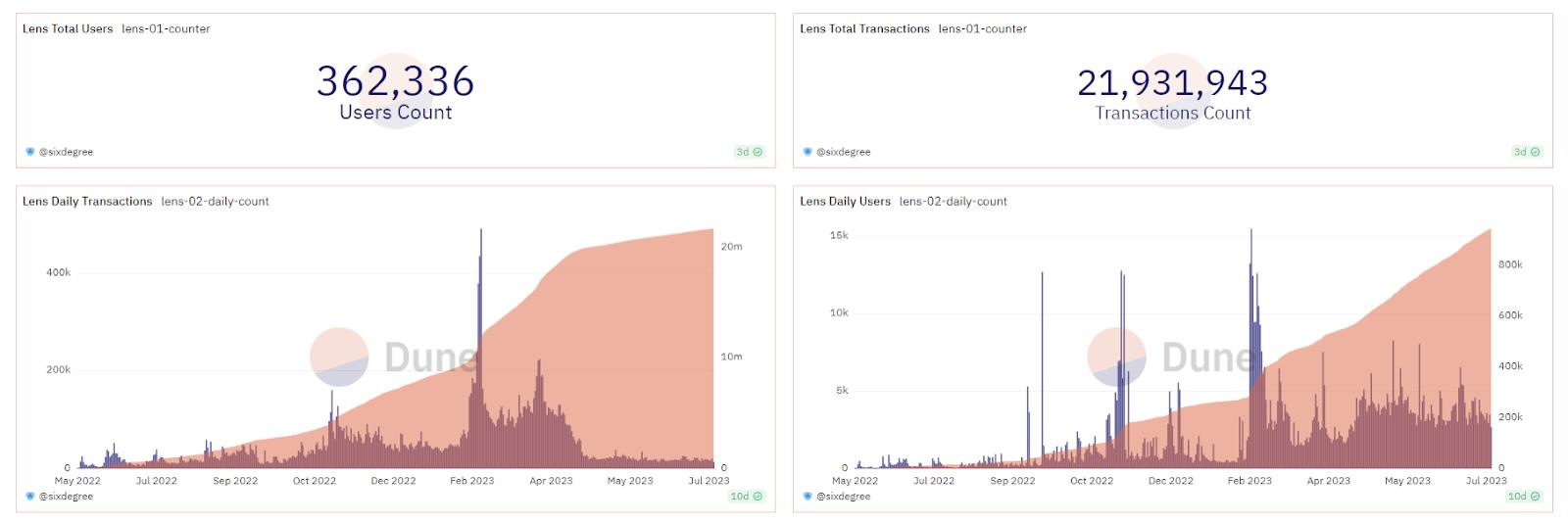
Overall, social graphs serve as the infrastructure and common tools for the entire social track. A unified, simple, and convenient social graph helps lower the usage threshold for users, reduce barriers between different DApps, and consolidate more users and data. In comparison, Lens Protocol, built on Polygon, focuses on creating its social ecosystem, while CyberConnect does not have its content platform and ecosystem; it supports multiple chains and interacts with various applications while actively exploring ways for Web2 users to enter, focusing on creating open social profiles. Both projects are currently leading projects in the social track, and with further development and launch of Lens Protocol, the social track led by these two projects may enter an explosive period.
Social Applications
Farcaster
Farcaster is a decentralized social platform created by former Coinbase executive Dan Romero, built on Ethereum and aimed at competing with Twitter. It is currently in the beta testing phase. Farcaster achieves a decentralized social interaction experience comparable to Web2 by generating and storing identity information on-chain while providing a database Hub to store other information off-chain, allowing for quick and low-cost interactions. Additionally, Farcaster allows users to use a self-hosted model, enabling them to send and receive messages without a gateway, ensuring decentralization. Currently, nearly 20 derivative projects have been built within its ecosystem, including data analysis, image beautification, trending topics, related topics, and search engines.
As of August 9, 2023, the total number of wallet addresses on Farcaster has surpassed 13,000, with several prominent figures in the crypto industry, including Vitalik Buterin, registering accounts. The user growth rate for the week was 2.2%, with 2,500 posts made in the past seven days. As an independent social application, its user count and activity level are quite good.
Currently, aside from the advantages of decentralized anonymity, how to attract Web2 users to migrate from Twitter to Farcaster is an important research direction for the project's future development.
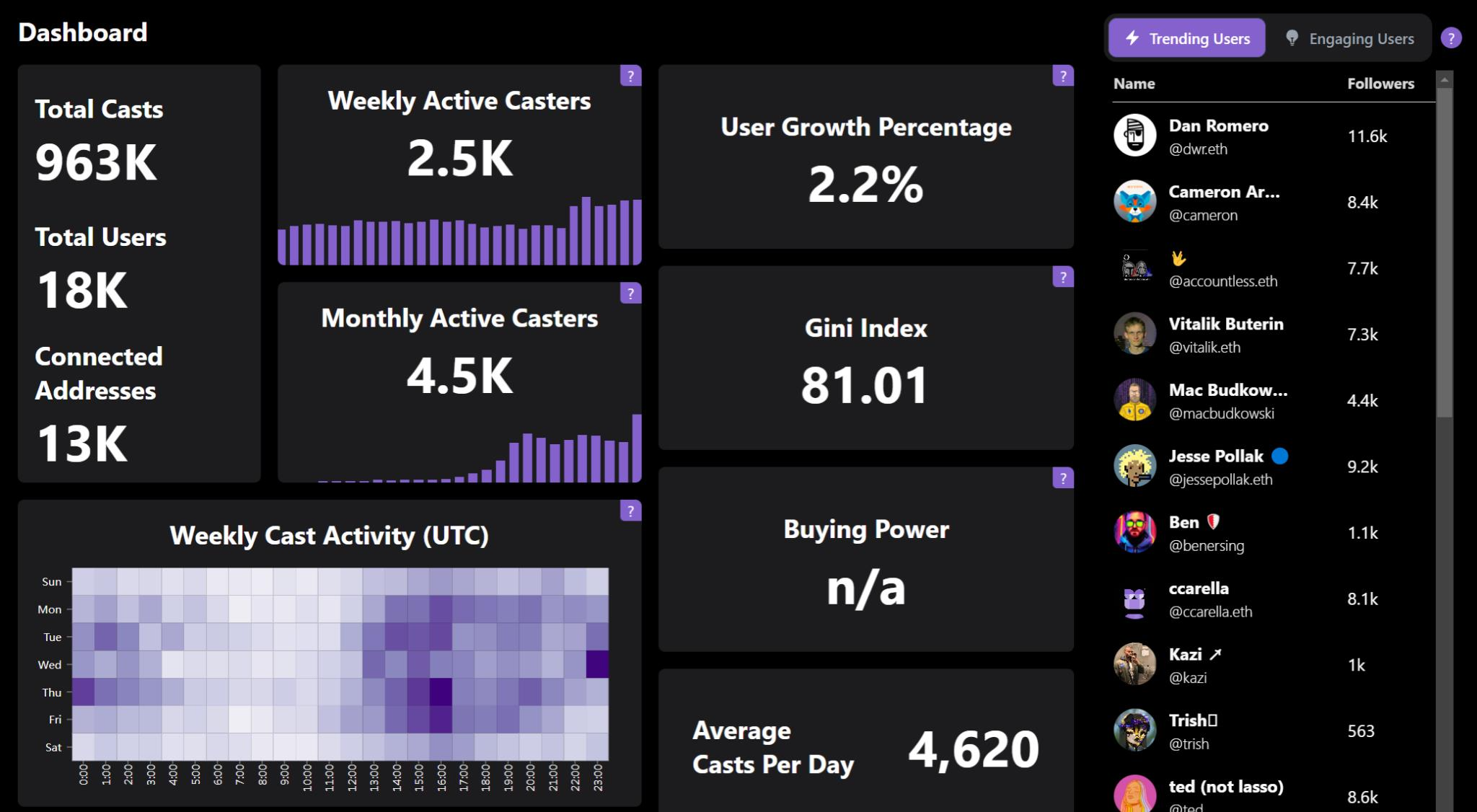
Farcaster User Data Statistics
Nostr
Nostr is a decentralized open-source social transmission protocol that allows developers to build DApps based on it. There are no centralized servers on Nostr; the protocol uses a design of clients and relays to achieve information transmission. Compared to Web2 social, this protocol achieves complete decentralization, can resist censorship, and protect user privacy. Damus is a decentralized social product built on Nostr, allowing users to experience a social platform similar to Twitter while enjoying the characteristics of decentralization, anonymity, and ad-free experience. This product is still in the early stages of development and has received recommendations and support from Twitter founder Jack Dorsey.
As a completely open, anonymous, and decentralized anti-censorship product, Damus has strong competitiveness in privacy and security compared to traditional social products, with clear markets and target customers. However, to attract a broader audience of Web2 users, new product designs and features may be needed.
Friend.Tech
Friend.Tech is a social application deployed on Coinbase's L2 chain BASE, backed by Paradigm. This application is similar to traditional fan token/creator economy projects, providing creators with fan communities and token issuance services, allowing users to join creators' communities by holding tokens issued by them. Since its launch on August 10, the product has rapidly gained popularity. As of August 29, 2023, in less than 20 days since its launch, it has registered over 120,000 addresses, with more than 20,000 active addresses (users checking their spaces on that day).

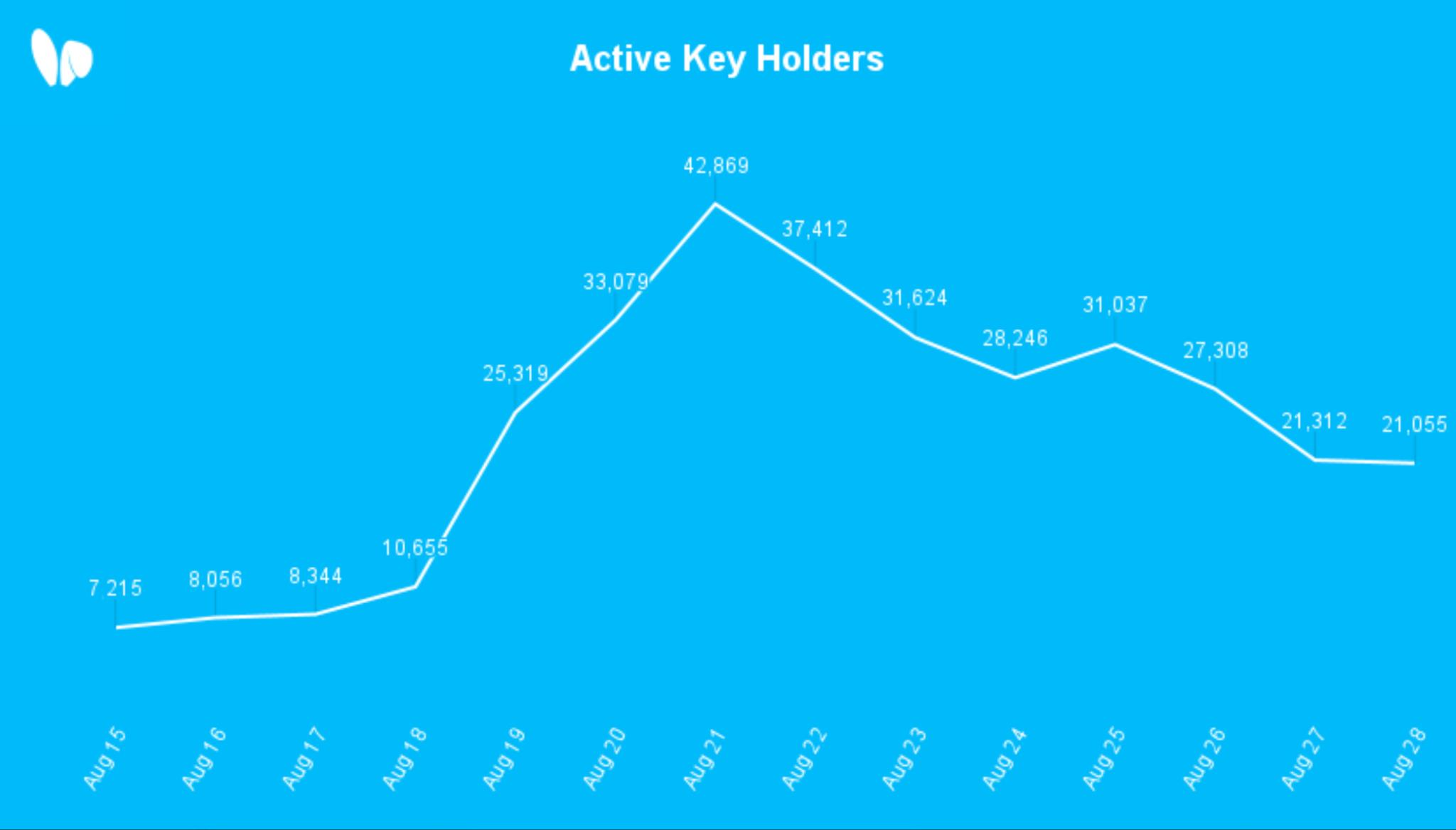
Users are required to pay a 10% transaction fee for each transaction, with 5% going to the creator and 5% to the protocol. As shown in the figure below, as of August 28, 2023, the protocol has accumulated over $4 million in revenue.
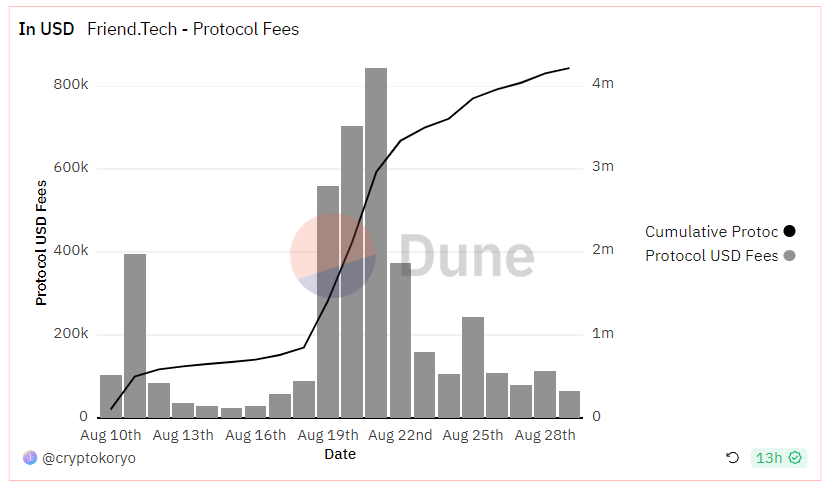
The rapid rise of Friend.Tech has sparked market attention and speculation about the social track, questioning how this product has managed to attract users so quickly and on such a large scale. This article believes that, in terms of the product itself, Friend.Tech has not deviated from the existing social product and token model design. However, its current success can be traced back to several key points:
1. The Ponzi Economic Design of Fan Tokens
Currently, there are two main models for fan token design: one is to issue fan tokens, where users hold a certain number of fan tokens to meet the entry threshold for the creator community. Fan tokens follow market economic price fluctuations, and there may also be designs for buybacks, burning, profit-sharing, and staking of fan tokens; the second is to issue fan NFTs, where users hold NFTs to meet the entry threshold for the creator community. NFTs also follow market economic price fluctuations, and there may be mappings for new token issuance, airdrops of new NFTs, or other rights realization.
Overall, in the token economic designs prior to Friend.Tech, the driving force behind the buying and selling of fan tokens mainly came from users' affection for creators, while the attraction of token price fluctuations was neutral. The user invitation mechanism combined with fan token economics introduced by Friend.Tech has disrupted the previously stagnant token economic mechanism. Friend.Tech has stated that it will distribute 100 million points within six months, although the rules for point distribution have not yet been disclosed. However, user points are generally believed to be linked to token airdrops. This mechanism, combined with the user invitation mechanism, promotes user acquisition motivation while encouraging users to purchase more shares of different creators to increase transaction fees and data. This strategy is similar to Blur's airdrop strategy, attracting users to use the product through long-term point incentives and airdrop expectations. Additionally, due to the long cycle, it can increase user stickiness to the product, allowing it to maintain market share even after the airdrop cycle ends.
In terms of token economics design, since the official has not disclosed relevant calculations, based on the widely accepted calculations by Laurence Day regarding this price model, as shown in the figure below, the price of Friend.Tech's fan tokens follows the price curve P=supply^2/16000. Under this pricing model, both price increases and decreases will present exponential fluctuations. Early investors have the opportunity to enjoy huge profits, and this Ponzi economic design will continue to trigger price surges before the buying and selling of users reach equilibrium, attracting more speculative users to participate in token trading. This is one of the most important reasons for the project's explosive growth in a short time, and similar designs have also been reflected in the Meme project XEN, where the Ponzi economic token design and early user dividend incentive mechanism led to a short-term market explosion.

2. The Initial Dividend of the BASE Chain Launch
Friend.Tech was initially built on other chains, and its recent popularity is also closely related to the heat of BASE and the L2 track. Since the launch of Arbitrum at the beginning of 2023, the L2 track has performed exceptionally well in the bear market. The subsequent ecosystems of Zksync, OP Stack, and BASE have sparked market enthusiasm, and it is expected that Starknet, Scroll, and Zksync will also launch and issue tokens this year. Coupled with the upcoming Cancun upgrade, the entire L2 can be regarded as the most important and eye-catching track in the crypto circle in 2023, with BASE also backed by Coinbase, a listed trading platform in the crypto field. Friend.Tech cleverly seized the market's hot spot and time dividend by launching at the early stage of BASE.
3. Endorsement by Top VC Paradigm
As a top investment fund in the crypto circle, Paradigm's endorsement naturally adds value to the project. Even when Friend.Tech had not yet developed a web version and only had a rough beta version, lacking various project white papers and explanatory materials, the market still placed trust in the project and invested a lot of enthusiasm, which is greatly related to Paradigm's endorsement. Additionally, the project's point mechanism shows incentive designs similar to Blur, which may have been guided by Paradigm.
Overall, Friend.Tech has a relatively traditional product mechanism, but its token economic design, customer acquisition strategy, and marketing methods are bolder than traditional social projects. In the short term, Friend.Tech may replicate Blur's user growth path, but as a social product, the realization of long-term social attributes will need to be observed after the product launch.
Tool Projects
Social tool projects mainly serve functional purposes, with most currently positioned to serve projects, such as Lenscan for browsing data under Lens Protocol, LensDAO for organization and community management, Alertcaster for information reminders under the Farcaster ecosystem, and FarQuest for initiating surveys. Other general auxiliary tools can also be categorized into the social tool category, such as the Debank Hi module for social promotion, Utopia for DAO treasury governance, and various NFT design tools, account management tools, wallet management tools, etc.
Overall, the social track is a field where developers can fully unleash their imagination at the application layer. In addition to social graphs and application tools, various types of social platforms, fan platforms, streaming platforms, and more are flourishing. Currently, this track is still in its very early stages, and the enthusiasm and efforts of developers and investors will continue to help accumulate results in this track.
Risks and Challenges
The current crypto social track has attracted numerous developers and capital participation. While recognizing opportunities, we should also clarify the risks and challenges that exist in this track. The current issues mainly lie in technology, user growth, and compliance.
Technical Challenges
Social products are generally at the application layer, and their development depends on the maturity of infrastructure and technology. As the number of users grows, there will be more and higher demands on social products. Additionally, the development of social applications relies on solving issues related to data storage, cross-chain information transmission, information transmission costs, network congestion, etc. However, the current infrastructure is not yet sufficient to support the emergence of social software that can accommodate Web2-level large-scale users.
User Growth
Aside from anonymity and anti-censorship, why would Web2 users be willing to switch to Web3 social applications? It can be clearly stated that not every user has extremely high privacy requirements; many users can still meet their social needs on existing centralized social platforms. Excluding this group of users, how to attract more users, or should the target users focus solely on those with privacy needs? If considering using economic returns to incentivize users, how should the economic model be designed to avoid falling into economic closed loops or Ponzi economic dilemmas? At the user level, Web3 social has already achieved good market heat and traffic, but the current heat still remains within the crypto circle. The future challenge for Web3 social products in increasing user numbers is whether to solve existing social product issues or create new functions and demands.
Compliance
The selling points of Web3 social products are also the main differentiating factors from Web2 products, which include three aspects: first, decentralization, anti-censorship, and privacy protection; second, users control data ownership; third, users can realize benefits from data ownership. The advantages of Web3 social products may also become risk points. It is foreseeable that the characteristics of Web3 products are likely to attract participants from the black and gray industries, while also drawing the attention of regulatory agencies. As the Web3 track matures and the user base expands, developers' security issues and potential inquiries from regulatory agencies must be considered in advance.
Conclusion
The Web3 social track is in the early stages of development, relying on the maturity of other infrastructure, including but not limited to cross-chain information transmission, data storage, reduced transaction costs, and compliance issues. Currently, social track products mainly include social graphs, social tools, and social applications, with social graphs being the most fundamental and social applications being the most numerous and diverse. Currently, many developers are attempting to develop Web3 social products, and capital is gradually paying attention to and investing in this track. The launch of the Cyber token, Twitter's rebranding, and creator incentive programs all demonstrate that the market heat for the social track is gradually rising. While opportunities are emerging in social, we should also fully recognize the challenges currently faced by this track. This article believes that the main challenges include the current inadequacy of infrastructure technology, bottlenecks in new user growth, and potential compliance issues. Overall, this article believes that the Web3 social track performs well in terms of development prospects, trends, and market heat. With the improvement of infrastructure, project development, capital accumulation, and token listings, this sector has good investment potential and development prospects.













